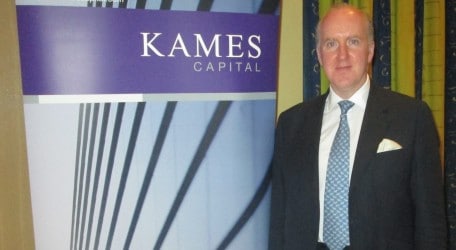
Kames Capital investment manager briefs local financial intermediaries
Edinburgh-based John McNeill (pictured above), Investment Manager, Fixed Income, at Kames Capital, briefed local financial intermediaries this week on the global fixed income markets and the drivers behind the continued global volatility during a brief visit to Malta.
Mr McNeill, who has 26 years’ industry experience, joined the award-winning Kames Capital fixed income team in 2006. He studied Economics at StrathclydeUniversity and holds a CFA charter. He previously worked with Resolution Asset Management, where he managed overseas bond funds.
There is currently a more benign investment environment since the 2008 financial crisis, according to Mr McNeill, who noted that many global indicators, including manufacturing output, global-PMI and OECD leading indicators were picking up. The weak period in the middle of 2012 has given way to a cyclical improvement.
Although in the US there were a number of political risks to the outlook, there were three reasons for optimism: energy, through cheap gas, is enabling manufacturing to be more competitive than in other countries; the housing cycle was showing more activity, ensuring that consumer durables and associated expenses would contribute to GDP growth; and the financial system was sufficiently healed to enable it to create credit.
In Europe, the European Central Bank had ensured stability but the banks took the liquidity that the ECB made available to reduce their balance sheets rather than to grow. There was also a need to be cautious on emerging market debt.
Mr McNeill said although there was more momentum than people perhaps anticipate, there were distinct regional differences and this momentum was not uniform. In reply to the question, are we in a bond bubble, he said by a matter of simple arithmetic a lot of the value had been extracted from this asset class, noting that high yield bonds were offering attractive total returns in a relatively low return world.
He anticipated that yields of government bonds would remain the same or rise slightly and that annual total returns may be in the range of 2-3%; investment grade bonds would be at 5-6% and high yield bonds would return 6-8%. In the past two years the high yield market has returned the coupon income.
As to whether there would be a great rotation in investment trends, Mr McNeill asked: who is going to rotate – mature pension funds and insurance companies were not prepared to take the risk of increasing allocations to equities. It may make sense personally but there was not the capacity to do so from global institutions.
As to the banking market, financial institutions and banks today are different and of higher quality with less leverage than they were before the financial crisis, plus having the support of European and national central banks. The spread offered by financial corporate debt was attractive relative to industrial credits.
Cash rates are low or negative. Government bonds were fully valued and in a low-yield scenario even meagre incremental amounts of yield were worth going for.
What was of concern was the extraordinary monetary policy of the major economies, including the Federal Reserve Bank in the US pumping $85 billion into the economy every month, Japan, UK and Switzerland, among others. This pointed to a potential distortion of prices which could lead to problems in the future when policy has to be tightened.
Concluding, before a lively question and answer session, Mr McNeill said that we are currently in a better place in the business cycle than we have been for some time. There are distinct regional variations in that. It is a reasonable outlook for the high yield asset class and asset markets more generally but a lot of the value has already been extracted.
Kames Capital does not see a massive exodus from fixed income but there may be competing asset classes or alternative asset classes which offer better total returns. In general central banks will continue to be accommodative. Official rates will be kept very low. Government bond yields will probably be lower than you think they should be.
- February 27, 2013 No comments Posted in: Business





